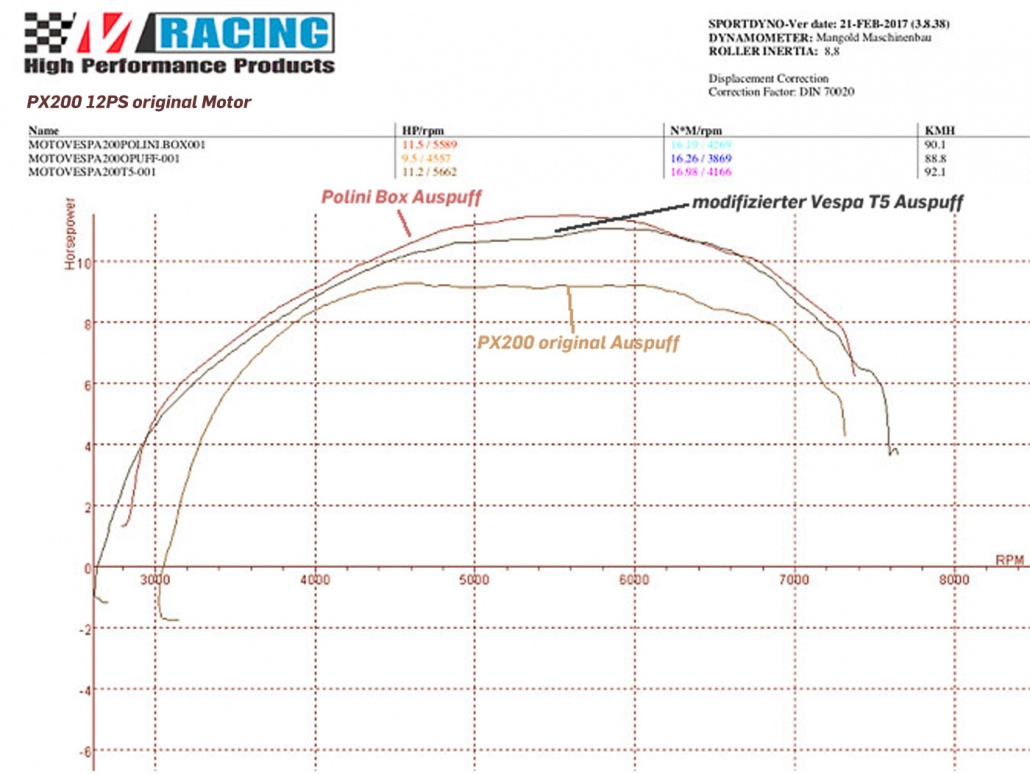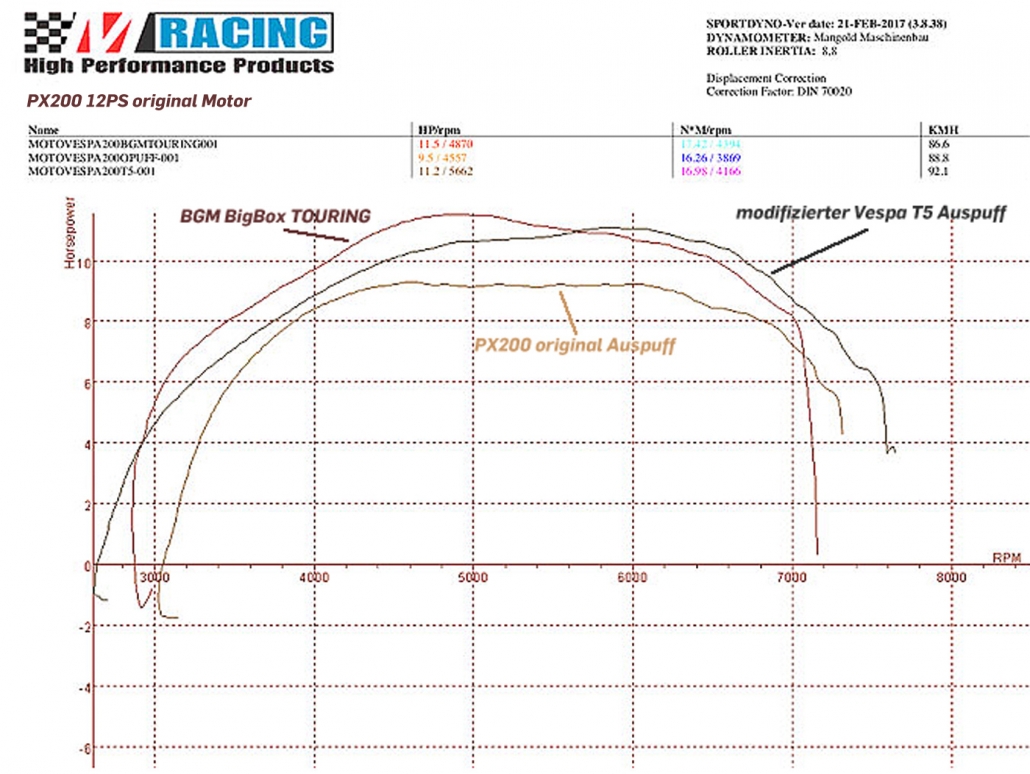Test Vespa Box Exhaust
Boris Goldberg, in cooperation with MMW Racing, has made a very complex exhaust test for the Vespa PX200 models on behalf of the very informative English online magazine ScooterLab.uk (SLUK for short). The focus of the test here was on the now very popular box exhaust systems. This means exhaust systems that are more or less similar to the original exhaust in appearance and sound, but offer a much better performance like the BGM BigBox Touring or Polini Box.
To make the results accessible to all readers, here is an excerpt of the most interesting tests.
In general, tests were carried out on two different engines:
- Original PX200 12hp engine
- PX200 engine with Malossi 210 sport cylinder, long stroke racing crankshaft (60mm stroke with extended intake control angle), SI24 carburetor

EXHAUST COMPARISON PX200 ORIGINAL ENGINE
The original PX200 motor is designed as a throttle motor. As a result, it offers high torque with a flat power curve.
Due to the short steering angles and small flushing surfaces, the engine cannot be operated sensibly with a classic racing exhaust. The loss of torque in the lower range is so great that there may be problems with the gear connection from third to fourth gear. The engine falls exactly in the range where the racing exhaust has significantly less power than the standard exhaust at shift speed. Under unfavourable conditions, the engine then literally starves to death in fourth gear and doesn’t get any faster than in third gear.
This is, besides the optical and acoustic inconspicuousness, one reason why the box exhaust systems have become so popular. These offer, with almost the same performance as a ‚real‘ racing exhaust, a much more linear performance curve without any drop in performance. Thus, the engine with a box exhaust is usually much more harmonious and relaxed to drive.
The Polini Box and Big Box Touring are a perfect example of how a good exhaust system can help a production engine get started.
Polini has developed its exhaust system very close to the Big Box Touring, which was previously available on the market.
On the original engine, the BigBox Touring is clearly ahead in terms of torque and power:

POLINI BOX ON PX200 ORIGINAL ENGINE
The power curve of the original Piaggio PX200 exhaust always serves as a reference. In addition, an exotic, not for sale, was also included in the diagram (an exhaust of the special model PX125 T5 which was equipped with an exhaust manifold of the PX200).
The Polini Box runs very harmoniously on the production engine. It widens the usable speed range and increases the available torque and power already relatively considerably.
Compare the lower yellow curve of the original exhaust with the upper red curve. The motor speed is specified via the left/right axis and starts at 2800 rpm. The motor power is read via the vertical axis, the higher the curve the higher the motor power at the given speed.
The original exhaust reaches here 9,5 HP which is the normal rear wheel power of a 12 HP Vespa. The 12hp are measured at the crankshaft in the factory, without the losses through the gearbox, tyres etc.
The Polini Box achieves a maximum of 11,5hp, already 2hp more than the standard exhaust. The absolute torque is identical with the standard exhaust.
Performance data and improvement compared to the original exhaust: 11,5HP/16,2Nm (+2,0HP/+0,0Nm)

BGM BIGBOX TOURING ON PX200 ORIGINAL ENGINE
The BGM BigBox Touring runs on the standard engine again much more powerful than the Polini. Up to about 5700 rpm, i.e. exactly in the speed range for which the original gearbox was tuned, the BigBox Touring is significantly higher than the already good Polini Box. The slightly earlier end of revs at 7000 rpm (Polini 7400 rpm) is not relevant because the standard engine in fourth gear (due to the normal driving resistances) only turns up to 6000 rpm anyway.
On an original engine the BigBox Touring is therefore still unbeaten when it comes to early, high torque with very good bandwidth.
It gives the original engine, without other modifications, a plus of 2 HP. Compared to the Polini it also increases the absolute torque by more than 1Nm.
This is already noticeable while driving, because this higher torque extends over the wide speed range of 3000-5500 rpm, which is very important for everyday use.
Performance data and improvement compared to the original exhaust: 11,5HP/17,4Nm (+2,0HP/+1,2Nm)
EXHAUST COMPARISON ON PERFORMANCE UPGRADED ENGINE WITH MALOSSI 210 SPORT CYLINDER
The converted engine in this test is, despite the modified cylinder and crankshaft, still extremely tour-friendly and rock solid with, albeit very sporty, classic Vespa characteristics. The engine thus develops from the speed cellar at least the same power as a standard engine, with significantly better performance in the medium and upper speed range.

POLINI BOX ON PX200 ENGINE WITH MALOSSI 210CCM CYLINDER
On the Malossi Sport cylinder the Polini Box works very well and offers a considerable plus compared to the original exhaust (+5,4HP). Up to 4200 rpm it is slightly below the level of the original exhaust, but then from 6000 rpm it takes in air again and offers a good top performance.
Performance data and improvement compared to the original exhaust: 21,2PS/23,7Nm (+5,4PS/+3,4Nm)

BGM BIGBOX TOURING ON PX200 ENGINE WITH MALOSSI 210CCM CYLINDER
On the Malossi Sport cylinder the BGM BigBox Touring works perfectly and offers a very high torque virtually from idle. At 5000 rpm it is a whole horsepower more powerful than the Polini Box and reaches its power peak already at 6000 rpm. So here too the name says it all and every touring rider is on the safe side with the BigBox Touring in terms of perfect rideability and thrust from the rev cellar. Compared to the standard exhaust, +3.5Nm are taken out of the engine here, all this at a significantly lower speed level. If you are in a hurry, you can benefit from the wide speed range of the BBT which still allows the engine to turn easily up to 7500 rpm with a lot of power at the rear wheel. With a standard gearbox this is already over 125km/h, whereas such an engine pulls a longer gear ratio without any problems. Fast motorway stages are therefore not only no problem despite the early onset of torque, they are also a lot of fun!
Performance data and improvement compared to the original exhaust: 19,9HP/23,8Nm (+4,1HP/+3,5Nm)

BGM BIGBOX SPORT ON PX200 ENGINE WITH MALOSSI 210CCM CYLINDER
Friends of the classic two-stroke characteristic will love the BGM BigBox Sport. If you expect the resonance kick*, turning out a wide range and at the same time a high peak performance, you’ve come to the right place. On the Malossi Sport cylinder she is still a bit underchallenged, but this one is ideal for all those who want to expand their engine concept. The Malossi Sport cylinder is perfectly suited for this purpose, as it offers the same overcurrent layout as the much stronger MHR brother.
The latter works best on a diaphragm controlled inlet (or a heavily reworked rotary vane inlet) together with a large carburettor. Therefore, MHR was not used as a basis in this test. However, increasing the head angle as well as the exhaust window quickly brings the Malossi Sport cylinder into very high performance regions. Engine outputs of well over 25 hp are then possible without any problems with the BBS, as the BigBox Sport is also known in short form.
But even on an engine that is still quite conventionally constructed, as used in this test, the BBS has the winning crown in terms of top performance. The nice thing about it is that despite the highest power peak in the test field up to 5000 rpm it runs almost as powerful as a standard exhaust. This is rather unusual for exhaust systems with high peak performance. But from 5000 rpm there is no holding anymore and the exhaust starts to charge fully. The high peak power is then maintained over a wide speed range. Perfect for chugging through the city without attracting attention and for getting the performance hammer out in between. As already mentioned, the BigBox Sport works much better on more powerful engines and does not stop at a power of more than 30HP/30NM (see also the performance diagrams in the online shop). In summary, one can say that the BBS is the proverbial wolf in sheep’s clothing.
(*you can feel the turbocharged use of the exhaust)
Performance data and improvement compared to the original exhaust: 22,0PS/23,7Nm (+6,2PS/+3,4Nm)
Buy BGM BigBox here POLINI Box buy here


